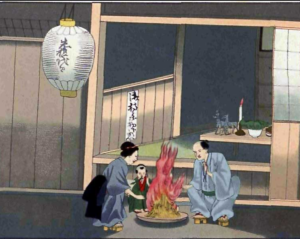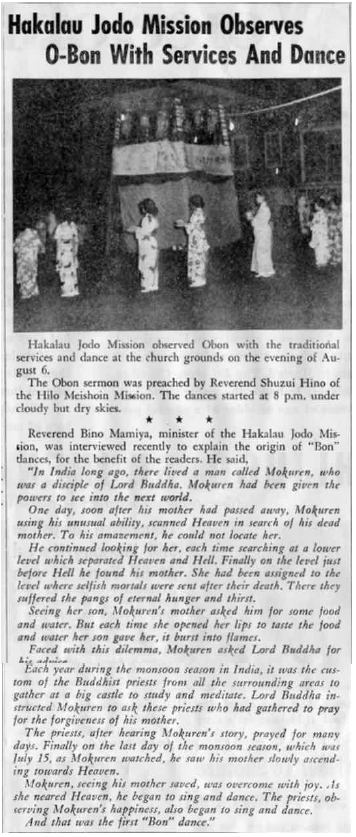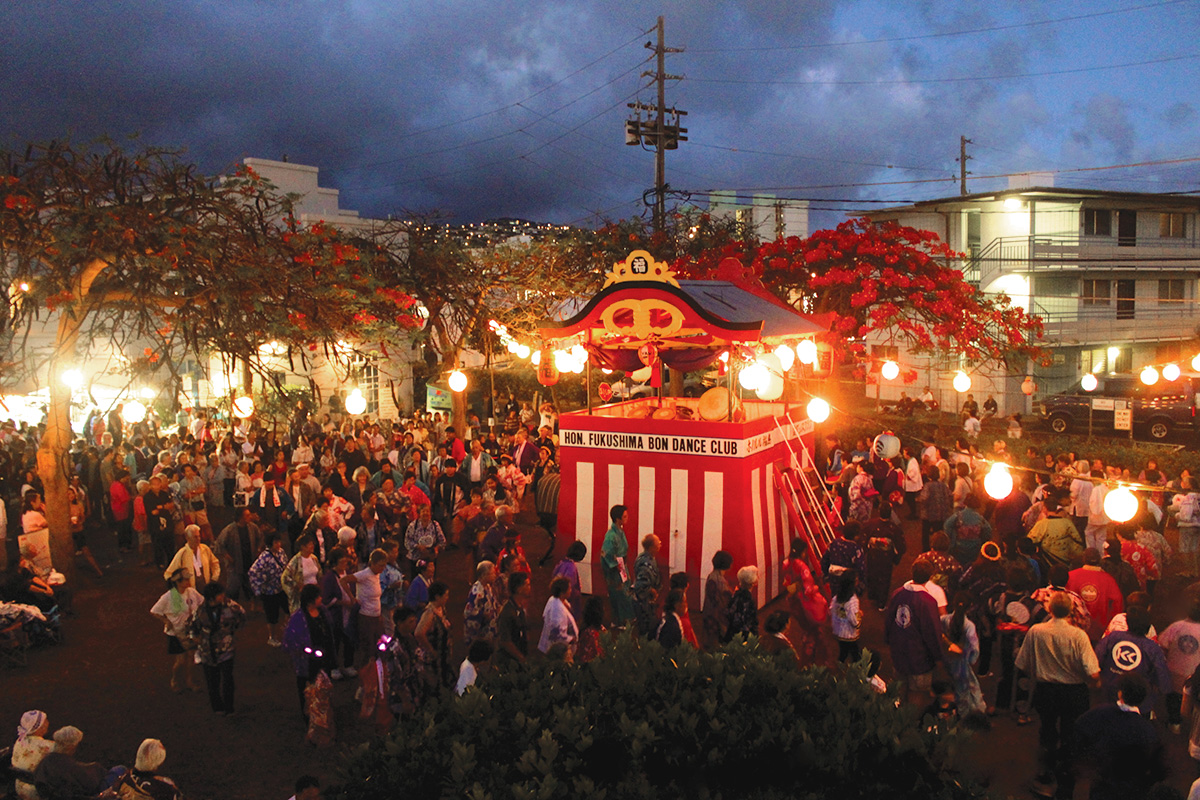In Hawai‘i, the Japanese o-bon season is widely known for its bon odori (dance festivals) which are held across the Islands, attracting crowds of people throughout the summer. The festival season traditionally kicks off in early June at the Hawai‘i Plantation Village in Waipahu and at least one festival is held every weekend thereafter. The simple joy of gathering with friends to dance, donning a colorful yukata (cotton kimono) or hapi coat, following the rhythmic beat of taiko drums on a hot summer evening is a special memory for many. Although this year live bon dances in Hawai‘i have been cancelled again due to the covid-19 pandemic, many temples are offering virtual celebrations (see notes below).
Beyond the merrymaking–what is the meaning of o-bon? Reverend Junshin Miyazaki of Hakalau Jodo Mission offered these reflections to share.
O-bon Sermon
by Reverend Junshin Miyazaki of Hakalau Jodo Mission

Depiction of obon customs, 1867 (courtesy Hakalau Jodo Mission)
O-bon is a mixture of many religions and cultures. The customs, the expression of O-bon, vary by region.
Generally, the belief is that the spirits of the deceased come back from the other world to this world during O-bon. People welcome the deceased by having a minister officiate at a service at the home altar, making cucumber horses and eggplant cows to ride, making a fire and hanging lanterns outside so the deceased do not get lost, offering good foods, and dancing all night under the full moon.
The deceased who passed away after the previous O-bon come back to this world for the first time. They are called Hatsu-bon or the First O-bon and people made much of it. The family hang a white chochin outside the house to help the Hatsubon spirit easily locate the house. In the temple, Hatsubon spirits are prayed for separately.
Where the deceased come back from depends on what they believe. Jodo Shu teaching says that the deceased are in the Pure Land of Amida Buddha. Those in the Pure Land have Six Supernatural Powers. Because Pure Land residents have these supernatural powers, they can see and visit us, they know we are thinking of them, and they never get lost.
Those who do not believe that the deceased are in the Amida Buddha’s Pure Land worried if the deceased would get lost and so forth. Therefore, they displayed cochin lanterns and cucumber horse and eggplant cattle, etc.
For Jodo Shu followers, O-bon is a good occasion to appreciate the Buddha and the deceased and renew our faith.

This sermon shares the origins of bon dances. Source: Voice of Hakalau, August 1960, from the Waichi Ouye Collection, courtesy of his family.
I hope we will have lively O-bon festival again next year.
Please stay safe and healthy, repeat Namu Amida Butsu often until then.
In gassho,
Rev. Junshin Miyazaki
Bon odori festivals are held to welcome the spirits of the dead and give thanks to one’s ancestors. The article at right explains how the tradition began in India centuries ago.
The minister of a Japanese Buddhist temple may commence obon festivities with a sanbujo or chant to invite and welcome Buddha(s). The chant also reminds the congregation to open their minds and receive Buddha’s guidance and dharma teachings.
Obon is a Buddhist observance, an opportunity to rejoice in the awakening offered by the Buddha. It is an opportunity to express our gratitude, not only to our ancestors, but to all who have passed and returned during the obon season.
– Reverend Toshiyuki Umitami, Moiliili Hongwanji Buddhist TempleLet’s lift up the spirit of togetherness of obon and be hopeful that next year will be a real bon dance just like years before.
– Bishop Shugen Komagata, Oahu Soto Mission
Bon dances are an annual source of income for Buddhist temples across the state, helping to sustain their general operations, community programs and upkeep of their historic buildings and facilities. Please consider how you can support the temple in your neighborhood.
Further exploration:
What Hawaii’s colorful Obon festival season is all about, by Maureen O’Connell, Hawaii Magazine
Bon Dance Hawaii Facebook page: announcements of upcoming virtual bon dance festivals and video of past festivals.
Oahu Soto Mission Virtual Bon Dance 2021 YouTube video
Photo at top courtesy Consuela Yokomura, Hawaii Magazine


